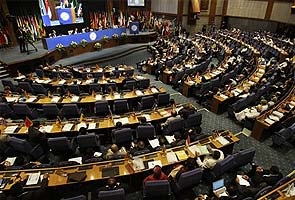NAM summit: Iran will try to prove it’s a global power

Tehran: In the biggest public relations initiative undertaken in the 33-year-old history of the Islamic Republic of Iran, the country hopes to shed its status of international pariah, as it gets set to host the 16th summit of the 120 member Non Aligned Movement.
 Over 30 heads of state are expected in Tehran between the 29th and 31st of August. Driving from the Imam Khomeini airport to the city, it is clear the Ahmadinejad government has spared no effort to welcome the leaders, nor in the message it is sending out to the West by hosting this summit. Massive hoardings along the highway welcome NAM leaders to the homeland of culture, as one puts it. Others talk about the need to avoid being enslaved, sending out messages of lasting peace through joint global governance. But one screams out at America: “nuclear energy is an undeniable right for Iran.”
Over 30 heads of state are expected in Tehran between the 29th and 31st of August. Driving from the Imam Khomeini airport to the city, it is clear the Ahmadinejad government has spared no effort to welcome the leaders, nor in the message it is sending out to the West by hosting this summit. Massive hoardings along the highway welcome NAM leaders to the homeland of culture, as one puts it. Others talk about the need to avoid being enslaved, sending out messages of lasting peace through joint global governance. But one screams out at America: “nuclear energy is an undeniable right for Iran.”
At the entrance to the convention hall where the summit will take place, it is hard to miss the wreckage of three cars, driven by Iranian nuclear scientists who were either killed or hurt in Bomb attacks. Tehran has insisted they were attacked by Israeli intelligence agents.
Both Israel and the United States have expressed their displeasure over the willingness of NAM leaders to attend the summit in Tehran and hand over the presidency of NAM for the next three years to it.
Sanctions against Iran and their impact
As the West is increasingly convinced Iran is pursuing nuclear weapons rather than nuclear energy, the country’s foreign minister Ali Akbar Salehi opened the meeting of foreign ministers on Sunday with a plea to Non Aligned nations to oppose US-backed sanctions against Iran for its nuclear programme. With currency devaluation and runaway inflation, the exchange rate on the black market today is about 21,00,000 riyal to a 100 US dollars. With food prices going up by the day, and growing youth unemployment, the sanctions have crippled the Iranian economy, hitting the ordinary middle classes the worst. As recently as July, the European Union’s ban on Iranian oil imports came into full effect, denying the country a market that was buying 18 per cent of its oil annually.
Given the squeeze from the West, Tehran is hoping to counter the damage of sanctions by wooing energy hungry countries like India and China. While India’s oil imports from Iran have fallen since the EU sanctions in July, they are still high enough to give the Iranian government a revenue cushion as the crisis plays out.
Iran is also hoping India will commit to investing nearly 100 million dollars in the Chahbahar port, that could help Delhi bypass Pakistan completely as a transit route for trade with key markets in Afghanistan. For India, trying to get Iran to move on this project going for nearly a decade, Ahmedinajad’s sudden willingness to push it forward means a diplomatic tightrope walk and the need to balance its own energy requirements and national interests in the face of concerns from America. As it courts Washington’s ire over the NAM summit, Delhi is hoping to bring Afghan president Hamid Karzai on board for a trilateral agreement, in order to take the agreement forward.
Iran’s public relations exercise
With the opportunity to host a summit as large as this one, Iran’s president Mahmoud Ahmadinejad will use the event to prove Iran’s legitimacy as a global power as America tries to isolate it on the world stage.
The event is so big, it has warranted a call for a three day government and school holiday. But if the sheer presence of these leaders is a PR victory for the Iranian president, he’ll have to tread carefully on several other fronts – most notably the concerns over the denial of higher education to women who have been banned from pursuing 771 courses at the graduate level in the country in the coming year. These include engineering, accounting, and chemistry among others.
Freedom of the press is another obstacle that Ahmadinejad will have to cross, especially as international media gathers in Tehran to cover the proceedings of the summit and the state of the country freely. Social networking sites are banned, as they have been since the beginning. A large media presence is being restricted from filming in public areas, even personal photography is restricted, although to a lesser extent.
Syria
The summit officially kicks off on August 30th, with several bilateral meetings scheduled for Prime Minister Manmohan Singh with the Iranian leadership, Pakistan President Asif Zardari, and possibly Egypt’s new President Mohammed Morsi, whose presence will be perhaps the most closely watched as an estranged Egypt reaches out to Iran to use its influence with Syria’s Alwaite president Bash’ar Assad to find a way to end the conflict. While India sees an opportunity in Iran’s proximity to Assad’s regime to do so, there is likely to be some tension over whether to include specifics of a resolution on Syria in the final declaration of the NAM document.
Everyone’s eye is on Iran, this time perhaps, for the right reasons. It is now up to the Iranian leadership to grasp the opportunity, and prove that it not only has the legitimacy of being of one of the grandest cultures of the world but that it also has a willingness to move forward on resolving conflicts that have plagued its relationship with the international community, for decades.





